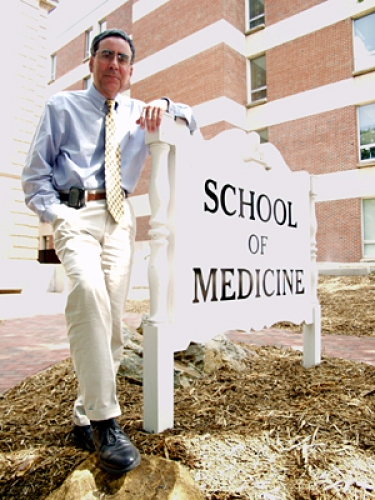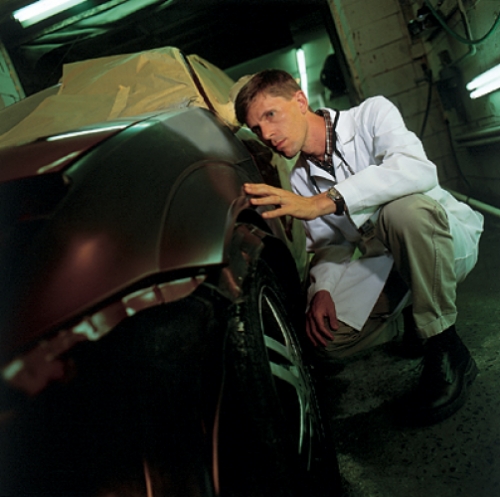Peering down the damaged front end of a Ford, Andre Ritter, assistant professor of operative dentistry, can’t help but think how the process of repairing this damage is similar to a process he plans to use to restore gum-line defects in teeth. Like repairing a dented fender, this new procedure begins by cleaning the surface. After rinsing the tooth surface with water, a coat of adhesive is applied to the tooth, much like the primer for a car. Upon “curing” the primer and applying the filling material, the tooth is shaped. The process finishes with a polish, making the tooth as shiny as a fresh paint job. The whole job takes 10 to 15 minutes per tooth and is an improvement over older techniques because it rarely requires anesthetic or drilling.
These gum-line defects are notch shaped and caused primarily by toothbrush abrasion and erosion from acidic foods and drinks. Unlike cavities, these are clean defects that require no invasive cleaning. As a result, the American Dental Association recommends them as models for the clinical evaluation of adhesive restorative material, such as the one Ritter uses. “With traditional restorative techniques, we have to cut teeth so that the filling will stay in the teeth mechanically,” Ritter says. This new procedure fixes defects with a dental adhesive, often making it unnecessary to cut into an otherwise sound tooth. If clinical evaluation at 6 and 18 months reveals at least 90 percent retention of the filling, the procedure is considered effective.
The tests that Ritter is conducting are called clinical trials — patient studies that determine the safety and efficacy of new drugs, treatments, or procedures. Ritter’s clinical trial tests a new procedure, but most clinical trials involve new drugs or treatments.
Successful drug clinical trials progress through four phases. The first two phases primarily establish safety of the drug. Phase III enrolls the largest number of patients, lasts longer, and generally costs more than the preceding phases because it’s designed to prove efficacy. All participants in Phase III are assigned, at random, to either the drug in question or a placebo — a process called randomization. Because a placebo is the inactive form of the drug and has no treatment value, comparing it to the drug allows assessment of the drug’s effectiveness. Those who receive the placebo are referred to as the control group or standard. After FDA review and approval, the drug enters Phase IV and becomes commercially available although its long-term effects are continuously monitored. The entire process from Phase I to Phase IV takes from 5 to 10 years.
Clinical trials provide national exposure for Carolina and are a growing enterprise. Industry-sponsored clinical trials numbered well over 300 and topped $34 million in fiscal year 2001, compared to about $11 million brought in by clinical trials in fiscal year 1998. But that growth has made these studies more difficult to get under way. So much so that in 2001, the university established a new office to help organize and shorten the process of initiating and conducting clinical trials. The Office of Clinical Trials, which opens this Fall, will consolidate where and by whom all the necessary paperwork gets processed. John Case, associate vice chancellor for research and interim head of the new office, calls it a “one-stop shop for principal investigators and their sponsors.” He says, “As a major health research institution, the more trials you get, the more exposure you get and the better for UNC-Chapel Hill to be nationally recognized.”
One of the researchers most familiar with clinical trials, Eugene Orringer, professor of medicine, has spent most of his life searching for cures and treatments for sickle cell disease, in which the normally round, slightly indented red blood cells are sickle shaped and sticky. A mutation in the hemoglobin protein causes the proteins to polymerize, or stick to one another in a repeating fashion.
“The biggest problem we deal with in sickle cell disease is what is called painful crisis,” Orringer says. These crises are severe episodes that send patients to the emergency room and require multiple-night stays and strong narcotics to control the pain.
One of Orringer’s clinical trials is the multicenter study of hydroxyurea, which Orringer and colleagues have shown decreases the number of crises in patients with sickle cell disease. Orringer thinks hydroxyurea works by stimulating fetal hemoglobin and suppressing adult hemoglobin that carries the sickle cell defect. Based on early studies, Orringer headed a clinical trial comparing adults on hydroxyurea to adults on a placebo.
“The bottom line,” Orringer says, “is that hydroxyurea not only reduced the frequency of painful crises, but it also reduced the number of episodes of chest syndrome.” This syndrome is a common, often life-threatening, pneumonia-like condition that is observed in sickle cell patients. “While hydroxyurea didn’t cure the disease, it certainly reduced dramatically the frequency of sickle cell-related complications.” Currently, hydroxyurea is the only FDA-approved treatment specifically for sickle cell disease. Inspired by these findings, Orringer says his lab is conducting additional clinical trials looking at other agents that might be combined with hydroxyurea to further enhance its response.
At any given time, John Buse, associate professor of medicine and director of the Diabetes Care Center, is involved in 10 to 15 clinical trials. One of these, NAVIGATOR, recruits family members of diabetics and tracks whether or not they develop the disease.
“We randomize them to a blood-pressure drug or placebo and to a diabetes drug or placebo and follow them for a period of about six years to see first whether we can prevent the development of diabetes, and second whether we can reduce the risk of dying of a heart attack or stroke,” Buse says.
Because most diabetics die of heart attack or stroke, many of Buse’s clinical trials incorporate conditions closely linked to diabetes such as high blood pressure and high cholesterol level.
A more classical clinical trial headed by Buse, INGAP, studies a protein discovered in hamsters. “If you inject this protein into diabetic rats and mice, it cures their diabetes,” Buse says. It works by coaxing the pancreas into making new islet cells, which are responsible for making insulin — the protein lacking in both type I and type II diabetes.
The opportunity to conduct clinical trials more efficiently will surely benefit the wide variety of ongoing clinical research at Carolina. “What could be more relevant than taking an idea that I had in the laboratory and applying it to a patient?” Orringer says. “And that is what we are all about here — trying to cure diseases.”
Tiffany Heady was a student who formerly contributed to Endeavors.




